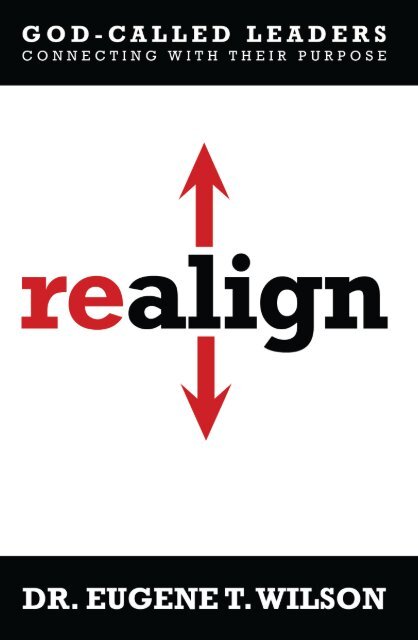God-Called Leaders and Their Purpose - Pentecostal Publishing ...
God-Called Leaders and Their Purpose - Pentecostal Publishing ...
God-Called Leaders and Their Purpose - Pentecostal Publishing ...
Create successful ePaper yourself
Turn your PDF publications into a flip-book with our unique Google optimized e-Paper software.
GOD-CALLED LEADERS<br />
AND THEIR PURPOSE
Acclaim for Realign:<br />
Eugene Wilson has provided a valuable resource for those who feel<br />
their leadership is “stuck,” resulting in frustration for both the leader<br />
<strong>and</strong> followers. The answer is a realignment of the leader in how he<br />
views his own success, how he goes about empowering others, <strong>and</strong><br />
how he postures the church for change <strong>and</strong> involvement. Wilson<br />
has extensively surveyed the wide scope of leadership philosophies<br />
<strong>and</strong> literature from the religious <strong>and</strong> secular fields, <strong>and</strong> woven them<br />
seamlessly with scriptural principles so we can be the beneficiaries of<br />
his convicting insights. I recommend Realign to leaders everywhere.<br />
— Raymond Woodward
GOD-CALLED LEADERS<br />
AND THEIR PURPOSE<br />
Dr. Eugene T. Wilson
Realign: <strong>God</strong>-<strong>Called</strong> <strong>Leaders</strong> <strong>and</strong><br />
<strong>Their</strong> <strong>Purpose</strong><br />
by Dr. Eugene T. Wilson<br />
© 2013 Dr. Eugene T. Wilson<br />
Cover design by Simeon Young Jr. at designforhire@me.com<br />
Interior design by Dennis Fiorini<br />
Published by Word Aflame Press, 8855 Dunn Road, Hazelwood, MO 63042.<br />
Printed in the United States of America.<br />
All Scripture quotations in this book are from the New King James Version of the Bible<br />
unless otherwise identified.<br />
Scripture quotations marked “NKJV” are taken from the New King James Version®.<br />
Copyright © 1982 by Thomas Nelson, Inc. Used by permission. All rights reserved.<br />
All rights reserved. No portion of this publication may be reproduced, stored in an<br />
electronic system or transmitted in any form or by any means, electronic, mechanical,<br />
photocopy, recording, or otherwise, without the prior permission of Word Aflame<br />
Press. Brief quotations may be used in literary reviews.
Dedication<br />
This book is dedicated to church leaders—past, present, <strong>and</strong><br />
future—many of whom have given all for the sake of the call. You<br />
have impacted my life. I am forever grateful.<br />
7
Contents<br />
Dedication ................................................ 7<br />
Preface ..................................................13<br />
Acknowledgements .....................................17<br />
Section One — The Leader. ..................... 21<br />
Chapter One – Redefining Success ...................21<br />
What Is the Problem? .............................23<br />
We Have Misunderstood Our <strong>Purpose</strong> .............25<br />
<strong>Purpose</strong> Impacts Success .........................26<br />
Lake-Model vs. River-Model .......................27<br />
A Proper Definition of Success ....................29<br />
Chapter 2 – Aligning with <strong>Purpose</strong> ...................35<br />
Church Models ...................................35<br />
The Membership Church Model. ................. 36<br />
The Program-Driven Church Model.............. 36<br />
The Seeker-Sensitive Church Model. . . . . . . . . . . . . 37<br />
Church Models Are Not the Answer ...............38<br />
What Is Our <strong>Purpose</strong>? .............................40<br />
Alignment Matters ................................44<br />
Chapter 3 – Becoming an Equipping Leader............ 51<br />
<strong>Leaders</strong>hip Defined ...............................51<br />
An Equipping Leader .............................52<br />
Equipping vs. Comm<strong>and</strong> <strong>and</strong> Control ..........53<br />
Organizational Life Cycles .........................57<br />
Entrepreneurial Stage. .......................... 57<br />
Collectivity Stage .............................58<br />
Formalization Stage ..........................58<br />
Elaboration Stage ............................59<br />
<strong>Leaders</strong> Must Grow ...............................59<br />
9
Release the People. . . . . . . . . . . . . . . . . . . . . . . . . . . . . . . . 61<br />
Chapter 4 – Traits of an Equipping Leader ............67<br />
Traits Of An Equipping Leader .....................70<br />
Character . ...................................... 70<br />
Scripture <strong>and</strong> Character. ........................ 71<br />
Character <strong>and</strong> Trust ...........................72<br />
Equipping <strong>Leaders</strong> are Bondservants ..............74<br />
Equipping <strong>Leaders</strong> Willingly Serve Others .........76<br />
Equipping <strong>Leaders</strong> Display Humility ...............78<br />
Section Two — The Process ........................85<br />
Chapter 5 – Underst<strong>and</strong>ing How People Change .... 87<br />
How People Change ..............................89<br />
Making Change Stick .............................91<br />
Learning Defined .................................92<br />
The Power of Questions ...........................94<br />
Learning by Doing ................................95<br />
Model the Change ................................97<br />
A Biblical Example ................................98<br />
Organizational Culture <strong>and</strong> Change ..............101<br />
Chapter 6 – Involving Others ..................... 107<br />
Lack of Commitment<br />
or Lack of Opportunity ........................108<br />
Shared Vision <strong>and</strong> Shared Ministry ...............109<br />
Sharing in Vision <strong>and</strong><br />
Ministry Helps Forge Unity .................111<br />
Sharing in Vision <strong>and</strong> Ministry Helps<br />
to Raise the Effectiveness of the Church .....114<br />
Empowerment vs. Delegating ....................115<br />
Followers ........................................118<br />
Types of Followers ...........................119<br />
Resource. . . . . . . . . . . . . . . . . . . . . . . . . . . . . . . . . . 119<br />
Individualists .............................119<br />
Implementer ..............................120<br />
Partner ...................................120<br />
Let the Church Speak ............................121<br />
Chapter 7 – Structuring for Equipping ..............125<br />
10
Organizational Structure Defined ................126<br />
Organizational Structure Matters .................127<br />
The Early Church<br />
<strong>and</strong> Organizational Structure ..................128<br />
Problems with Organizational Structures .........131<br />
Hierarchies .................................131<br />
Organizational Design ...........................133<br />
The Twenty-first Century Church<br />
<strong>and</strong> Organizational Structure ..................136<br />
Chapter 8 – Creating <strong>and</strong> Maintaining a Safe Place . 143<br />
The Value of Community .........................143<br />
Protecting Community ...........................145<br />
Unity ............................................147<br />
Involvement Increases<br />
When the Environment Is Safe .................149<br />
A Church Leader’s Responsibility .................152<br />
Epilogue. . . . . . . . . . . . . . . . . . . . . . . . . . . . . . . . . . . . . . . . . . . . . . . . . 157<br />
Work Cited ..............................................161<br />
Endnotes ................................................171<br />
11
Preface<br />
John Geirl<strong>and</strong>, in his article “Go With The Flow,” cites Mihaly<br />
Csíkszentmihályi, a Hungarian psychology professor who has<br />
been called the world’s leading researcher on positive psychology.<br />
Csikszentmihályi is known for his work in happiness <strong>and</strong> creativity,<br />
but he is best known as the architect for the notion “flow.”<br />
Csíkszentmihályi describes flow as<br />
being completely involved in an activity for its own sake.<br />
The ego falls away. Time flies. Every action, movement, <strong>and</strong><br />
thought follows inevitably from the previous one, like playing<br />
jazz. Your whole being is involved, <strong>and</strong> you’re using your skills<br />
to the utmost. 1<br />
Csíkszentmihályi became aware of flow while observing artists,<br />
especially painters, who became so absorbed in their work they went<br />
without food, water, <strong>and</strong> sleep for long periods of time. Historical<br />
sources hint Michelangelo may have painted the ceiling of the Vatican’s<br />
Sistine Chapel while in a state of flow. 2 It is reported he painted for<br />
days at a time, so caught up in his work he refrained from food or sleep<br />
13
Realign: <strong>God</strong>-<strong>Called</strong> <strong>Leaders</strong> <strong>and</strong> <strong>Their</strong> <strong>Purpose</strong><br />
until he reached the point of sheer exhaustion. He would then rest,<br />
<strong>and</strong> upon awaking, would start painting again <strong>and</strong> re-enter into flow.<br />
Upon hearing about “flow,” I quickly related it to some thoughts<br />
I had regarding churches. I noticed there were some churches that<br />
appeared to be “in the zone” (a term often used in sports to describe<br />
moments in which players perform in extraordinary ways). A church in<br />
“the zone” is much like an artist in the “flow.” There is a special energy<br />
<strong>and</strong> momentum. Much is accomplished. Sadly, many churches are not<br />
“in the zone.”<br />
I think most church leaders have a sincere desire to see the<br />
kingdom of <strong>God</strong> flourish. However, many church leaders feel<br />
unfulfilled in their calling. So how does a church get in the flow (or<br />
in the zone)? This question led me to my research, which in turn,<br />
resulted in this manuscript. I believe the answer to flow is found<br />
in principles, not programs, methods, or events. The principles<br />
by which flow is obtained originate in Scripture. However, these<br />
principles are at times displayed in a fuller or clearer sense within<br />
secular fields, as opposed to the church. Thus, I have drawn from<br />
both sources in writing this manuscript.<br />
What are these principles? Christian A. Schwarz, head of the<br />
Institute for Church Development in Germany, led a research project<br />
from 1994-1996, which he claims is the most comprehensive study<br />
ever conducted on what causes church growth. 3 In his survey of more<br />
than one thous<strong>and</strong> churches on five continents, Schwarz identified<br />
principles crucial for growth. He says,<br />
To my knowledge, our research provides the first worldwide<br />
scientifically verifiable answer to the question, “What<br />
church growth principles are true, regardless of culture <strong>and</strong><br />
theological persuasion?” We strove to find a valid answer to<br />
the question “What should each church <strong>and</strong> every Christian<br />
do to obey the Great Commission in today’s World?” 4<br />
14
15<br />
Preface<br />
Schwarz’s research identifies eight characteristics of growing<br />
churches: (1) empowering leadership; (2) gift-oriented ministry;<br />
(3) passionate spirituality; (4) functional structures; (5) inspiring<br />
worship; (6) holistic small groups; (7) need-oriented evangelism; <strong>and</strong><br />
(8) loving relationships. 5 This manuscript touches on many of these<br />
characteristics, especially empowerment, gift-oriented ministry,<br />
structures, <strong>and</strong> relationships.<br />
Mark Setch, in “Disciple-Makers,” says (concerning Schwarz’s<br />
research),<br />
Many Christians are skeptical of church growth because to<br />
them it presents techniques which seek to achieve church<br />
growth using human abilities, rather than <strong>God</strong>’s means.<br />
In contrast to this, Schwarz presents a different approach<br />
to church growth, which he calls ‘natural’ or ‘biotic’ church<br />
development. 6<br />
Schwarz states, “‘Biotic’ implies nothing less than a rediscovery<br />
of the laws of life (in Greek, bios). The goal is to let <strong>God</strong>’s growth<br />
automatisms flourish instead of wasting energy on human-made<br />
programs.” 7<br />
Schwarz helps us identify a fundamental problem with many<br />
churches in North America—our reliance on programs. Although<br />
programs are not inheritably wrong, they are not the answer to the<br />
problem that plagues the church. We have allowed our programs to<br />
direct our ministry rather than our ministry to direct our programs.<br />
Could it be that our emphasis on programs has led us farther away from<br />
our purpose than what we readily recognize? Could it be that we are<br />
so stuck in ruts <strong>and</strong> traditions that we have become institutionalized?<br />
Gary Hamel says,<br />
Over the centuries, religion has become institutionalized,<br />
<strong>and</strong> in the process encrusted with elaborate hierarchies, topheavy<br />
bureaucracies, highly specialized roles <strong>and</strong> reflexive<br />
routines. Religion won’t regain its relevance until church
Realign: <strong>God</strong>-<strong>Called</strong> <strong>Leaders</strong> <strong>and</strong> <strong>Their</strong> <strong>Purpose</strong><br />
leaders chip off these calcified layers [<strong>and</strong>] rediscover their<br />
sense of mission. 8<br />
This manuscript seeks to help church leaders do as Hamel<br />
suggests—get back to the basics <strong>and</strong> realign with purpose. It is not<br />
about a model, per se, as much as it is about principles—principles<br />
that are both timeless <strong>and</strong> universal, that help church leaders get into<br />
the mode of flow <strong>and</strong> accomplish great things.<br />
Finally, the book is separated into two sections: the leader <strong>and</strong><br />
the process. The first section addresses, among other things, church<br />
models, leadership theories, <strong>and</strong> organizational life cycles. While some<br />
readers may be prone to skim through this material, it is beneficial in<br />
underst<strong>and</strong>ing the scriptural principles regarding the role <strong>God</strong>-called<br />
leaders fulfill in the development of others, <strong>and</strong> is foundational in the<br />
implementing of the processes covered in section two.<br />
16
Acknowledgements<br />
Over the past several years I have received support <strong>and</strong><br />
encouragement from a great number of individuals. Dr. Corné Bekker’s<br />
words of encouragement, especially early on in my doctoral studies,<br />
helped me believe I could accomplish my goals. In addition, his<br />
dedication to proper exegesis of Scripture led me to dig deeper in my<br />
studies. Dr. Jay Gary, who offered me the opportunity to participate in<br />
a research project, helped to greatly improve my writing. Thank you to<br />
my fellow church leaders, some of whom afforded me the privilege of<br />
interviewing you for the practical application pieces at the conclusion<br />
of each chapter. My father-in-law, Simeon Young Sr., encouraged me<br />
to write <strong>and</strong> has been instrumental in my development. My father,<br />
Harrell Wilson, who is my hero, instilled in me the foundation from<br />
which my studies have sprung. My church family, church leadership,<br />
extended family, <strong>and</strong> close friends helped in their own special way<br />
to shape the person I have become. My mentors, with whom I have<br />
sought counsel, saw what I could be, when I could not. Finally, my wife<br />
<strong>and</strong> children, who supported me with unwavering faith, devotion, <strong>and</strong><br />
love, have helped to complete my journey. I am a better man because<br />
of you.<br />
17
Section One<br />
THE LEADER<br />
19
Section one — THE LEADER<br />
Chapter One –<br />
Redefining Success<br />
Christianity in North America is showing signs of trouble.<br />
Statistics suggest North America may be headed down the same<br />
slippery slope as Western Europe, where in most countries (Denmark,<br />
France, Germany, Great Britain, the Netherl<strong>and</strong>s, Norway, Sweden,<br />
<strong>and</strong> Switzerl<strong>and</strong>) people no longer find the church relevant <strong>and</strong> the<br />
majority of the population no longer believes in <strong>God</strong>. 1<br />
According to research by Pew Forum, the number of Americans who<br />
claim no religious affiliation has nearly doubled since 1990, rising from<br />
8 to 15 percent. 2 Meanwhile, the number of Americans who describe<br />
themselves as atheist or agnostic has quadrupled. 3 Jon Meacham, “The<br />
End of Christian America,” states, ‘“Two-thirds of the public (68 percent)<br />
now say religion is “losing influence” in American society, while just<br />
19 percent say religion’s influence is on the rise. Furthermore, the<br />
proportion of Americans who think religion “can answer all or most of<br />
today’s problems” is now at a historic low of 48 percent.”’ 4<br />
David Kinnaman <strong>and</strong> Gabe Lyons, in Unchristian, claim the<br />
Christian “br<strong>and</strong>” has lost its appeal, especially among young people. 5<br />
When polled, about 50 percent of young people say they have a<br />
neutral view of Christianity. However, among those who feel more<br />
strongly, the ratio of negative to positive views of Christianity is 2:1.<br />
21
Realign: <strong>God</strong>-<strong>Called</strong> <strong>Leaders</strong> <strong>and</strong> <strong>Their</strong> <strong>Purpose</strong><br />
And when asked how they felt about “Evangelicals” in particular, the<br />
ratio of negative to positive jumped to 16:1.<br />
Society’s negative view toward Christianity is reflected in the<br />
decline of church attendance across North America. Data from a<br />
General Social Survey reveals that from 1990 to 2008, the percentage<br />
of people who never attend religious services rose from 13 to 22<br />
percent. 6 David Olson, in The American Church in Crisis, states that<br />
in 1990, 20.4 percent of the population attended a Christian church<br />
service. 7 However, by 2005 the percentage had dropped to 17.5<br />
percent. If this trend should continue, by 2020 only one of seven<br />
individuals will be attending church regularly in North American.<br />
Statistics also reveal a decline in church membership. According<br />
to the National Council of Churches’ 2011 Yearbook of American<br />
& Canadian Churches, virtually all-mainline denominations are<br />
experiencing a decline in church membership. 8 As a result, many<br />
churches are closing their doors. Statistics reveal 3,500–4,000 churches<br />
annually cease to exist. 9<br />
Cathy Lynn Grossman describes the religious environment of the<br />
United States of America in not-so-favorable terms. She states,<br />
When it comes to religion, the USA is now l<strong>and</strong> of the<br />
freelancers. The percentage of people who call themselves in<br />
some way Christian has dropped more than 11 percent in a<br />
generation. The faithful have scattered out of their traditional<br />
bases: The Bible Belt is less Baptist. The Rust Belt is less Catholic.<br />
And everywhere, more people are exploring spiritual frontiers<br />
— or falling off the faith map completely. 10<br />
Statistics also indicate that ministerial pressure is increasing.<br />
Research by Barna, Focus on the Family, <strong>and</strong> Maranatha Life reveals<br />
the following: 11<br />
• Fifteen hundred pastors leave the ministry each month.<br />
• 50 percent of pastors’ marriages will end in divorce.<br />
22
Chapter One – Redefining Success<br />
• 80 percent of pastors <strong>and</strong> 84 percent of their spouses feel<br />
unqualified <strong>and</strong> discouraged in their role as pastors.<br />
• 80 percent of pastors’ spouses feel their spouse is overworked.<br />
• 80 percent of pastors’ spouses wish their spouse would choose<br />
another profession.<br />
• The majority of pastors’ wives surveyed said that the most<br />
destructive event that has occurred in their marriage <strong>and</strong> family<br />
was the day they entered the ministry.<br />
• 50 percent of pastors are so discouraged that they would leave the<br />
ministry if they could, but have no other way of making a living.<br />
• 80 percent of seminary <strong>and</strong> Bible school graduates who enter the<br />
ministry will leave the ministry within the first five years.<br />
• 70 percent of pastors constantly fight depression.<br />
Clearly, things are moving in the wrong direction. Something<br />
needs to change.<br />
What Is the Problem?<br />
What is happening? What is the problem? What must we change?<br />
And how do we make the changes that are needed? This book is<br />
written to individuals who care enough about the church to entertain<br />
such questions. It is written especially to church leaders—those who<br />
have been called by <strong>God</strong> as apostles, prophets, evangelists, pastors,<br />
<strong>and</strong> teachers—those who have been given the task of equipping<br />
others for the work of ministry. 12<br />
Something must change. We cannot afford to continue down<br />
the same path we have been on. Albert Einstein defined insanity as<br />
continuing to do something you’ve already been doing yet believing<br />
you will get different results. As church leaders, we need to pause long<br />
enough to look inward to see if we are contributing to the problem.<br />
We need to consider the possibility that we might be partially at fault<br />
for the current condition of the church. While it is certainly easier<br />
23
Realign: <strong>God</strong>-<strong>Called</strong> <strong>Leaders</strong> <strong>and</strong> <strong>Their</strong> <strong>Purpose</strong><br />
to blame external forces, it may not be nearly as advantageous or<br />
accurate. If we truly want things to change, if we truly want to make a<br />
difference in our world <strong>and</strong> in the lives of those to whom we minister,<br />
we must first examine ourselves.<br />
The seven churches in the Book of Revelation existed in a<br />
challenging environment. However, the problem with the church of<br />
Ephesus was not from without; it was from within. She had left her<br />
first love. The church of Thyatira’s problem was that she had tolerated<br />
the spirit of Jezebel. The problem with the church of Laodicea was<br />
lukewarmness. The church of Sardis’ problem was that she had fallen<br />
asleep. The problem with the church of Pergamum was not that it<br />
faced immense external pressures <strong>and</strong> existed “where Satan’s throne<br />
is” 13 ; the problem was that some of its members held to the teaching<br />
of Balaam <strong>and</strong> others to the teaching of the Nicolaitans. In spite of<br />
the challenges these churches faced externally, they ceased to exist<br />
because of their failure to deal with issues that existed within, not<br />
pressures they faced from without.<br />
We must stop blaming others for the current condition in<br />
which we find ourselves. Instead, we must initiate <strong>and</strong> engage in<br />
self-examination. Our problem is not secularism, consumerism, or<br />
postmodernism. Neither is our problem the devil. Jesus emphatically<br />
declared the gates of Hell would not prevail against the church. 14<br />
Additionally, our problem is not the lack of resources. The New<br />
Testament church had fewer resources than we do; yet they turned<br />
their world upside down. Neither is our problem lack of ability, skill, or<br />
talent. We are talented. We are skilled. And we have much ability. So<br />
what is our problem?<br />
I believe our problem is our lack of underst<strong>and</strong>ing <strong>and</strong> aligning<br />
with our purpose. We do not know exactly what it is we are called to<br />
do. Because we lack clarity of purpose, we exert effort on things of<br />
little benefit to the kingdom of <strong>God</strong>. We are skilled at things that do<br />
not matter <strong>and</strong> are novices at things that do matter. We must right<br />
ourselves by realigning with our purpose. Through realignment we<br />
can lay hold of <strong>God</strong>’s blessings <strong>and</strong> favor on our ministries.<br />
24
Chapter One – Redefining Success<br />
We Have Misunderstood Our <strong>Purpose</strong><br />
One day a gentleman from the city, who, while driving in the<br />
country, noticed a barn with targets painted on it <strong>and</strong> an arrow in the<br />
center of each target. Amazed at such expertise, he stopped to inquire<br />
about it. The marksman offered to showcase his talents. He got his<br />
bow. R<strong>and</strong>omly shot an arrow at the barn. Took a bucket of paint <strong>and</strong><br />
a paintbrush, <strong>and</strong> painted a target around the arrow. The marksman<br />
then said, “When I do it this way, I never miss.”<br />
Too many of us are like the marksman. We do not know what we<br />
should be aiming at. We lack clarity of purpose. Occasionally, we hit<br />
the target but not because we aimed for it; rather, we stumble upon<br />
it. This is not the way things should be. We should live our lives with<br />
purpose. We should function in our <strong>God</strong>-given call with clarity of<br />
purpose. We should be so focused on our purpose that trivial things<br />
are no longer able to detour us around what matters most.<br />
Asking the right questions enables us to aim at the right target.<br />
When we fail to ask the right questions we end up addressing the<br />
wrong problem. I was once told of a solution a group of ministers<br />
generated when addressing what to do with the dwindling crowds of<br />
church rallies—a fellowship event in which several churches gather to<br />
worship together. The solution was to hold the services in smaller-sized<br />
church buildings so the crowd would no longer appear to be small.<br />
No one bothered to identify the reason for the dwindling crowds,<br />
consider the purpose of the rallies, or determine if the underlying<br />
purpose of the rallies was being fulfilled through other venues. The<br />
failure to ask the right questions resulted in a solution that did nothing<br />
to address the real issue at h<strong>and</strong>.<br />
Taking aim at the right target is important. Failure to do so is a<br />
waste. Yet for some, the only thing that seems to matter is just doing<br />
something, as if doing something will somehow produce the right<br />
thing. This perspective resembles an octopus on roller skates—there<br />
may be plenty of movement, but there is no clear direction. Church<br />
leaders who approach ministry in such a manner run from program<br />
25
Realign: <strong>God</strong>-<strong>Called</strong> <strong>Leaders</strong> <strong>and</strong> <strong>Their</strong> <strong>Purpose</strong><br />
to program. They are constantly trying new things hoping something<br />
will work.<br />
A new program or church model may work at first. Eventually,<br />
however, it loses its effectiveness, <strong>and</strong> the search for a different<br />
program or model begins anew. Clarity of purpose as well as a proper<br />
underst<strong>and</strong>ing of principles behind the programs <strong>and</strong> models is<br />
needed. If there is no clear purpose or proper underst<strong>and</strong>ing of<br />
principles, a church leader will, in time, become frustrated <strong>and</strong><br />
disillusioned. In order to discover purpose <strong>and</strong> realign with it, church<br />
leaders need to ask strategic questions such as: Where are we now?<br />
Where do we want to go? How do we get there? By asking strategic<br />
questions, a church leader can discover, or rediscover, the intent <strong>and</strong><br />
purpose of the church as well as the fivefold ministry.<br />
<strong>Purpose</strong> Impacts Success<br />
You may be taken aback by my assertion that we lack a clear<br />
underst<strong>and</strong>ing of our purpose. However, I would argue our definition<br />
of success proves my claim. Most church leaders have defined success<br />
by the size of the congregation. We tend to gauge the effectiveness of<br />
the various ministries in our churches by looking at numbers. We even<br />
size each other up by determining who is successful <strong>and</strong> who is not<br />
based on the number of people we lead. If we were to use the same<br />
criteria, one that centers on numbers, in judging the earthly ministry<br />
of Jesus, we would deem it as unsuccessful. The crowd deserted Him,<br />
His disciples fled from Him, <strong>and</strong> Peter denied Him. But Jesus was not a<br />
failure; He was a success. In just three <strong>and</strong> a half short years of ministry,<br />
He founded a movement that quickly spread around the world.<br />
While we define success based on numbers, Jesus defined success<br />
based on doing the will of the Father. Our view of success leads to our<br />
becoming enamored with crowds; Jesus’ view of success led Him to a<br />
cross. Although Jesus drew large crowds, His ministry was not centered<br />
on the multitude of people who followed Him. He spoke to crowds,<br />
ministered to crowds, fed the crowds, <strong>and</strong> had compassion on crowds;<br />
26
Chapter One – Redefining Success<br />
however, His focus of ministry was not on crowds. On the contrary,<br />
Jesus spent the majority of His time ministering to individuals.<br />
Jesus’ focus on individuals can be seen in Matthew chapters eight<br />
<strong>and</strong> nine. In Matthew 8:3, Jesus told a leper, “I am willing; be cleansed.”<br />
To the centurion who sought healing for his servant, Jesus said, “I will<br />
come <strong>and</strong> heal him” (Matthew 8:7). In Matthew 8:14-15, Jesus entered<br />
the home of Peter, <strong>and</strong> seeing Peter’s mother-in-law lying in bed with<br />
a fever, He touched her, <strong>and</strong> the fever left. In Matthew 8:28-32, Jesus<br />
delivered the demon-possessed man from Gadara. In Matthew 9:6,<br />
Jesus told the paralyzed man to “st<strong>and</strong> up.” In verse 22, the woman<br />
with the issue of blood was miraculously healed. In Matthew 9:25, the<br />
daughter who had died was made to live again. In Matthew 9:29-30,<br />
two blind men were made to see. In Matthew 9:33, the demonic man<br />
who was a mute was delivered <strong>and</strong> began to speak. The one common<br />
element found in each of these stories was that Jesus ministered to<br />
individuals. The crowd was a by-product of the miraculous that took<br />
place in the lives of individuals Jesus touched.<br />
Lake-Model vs. River-Model<br />
Our definition of success has resulted in a faulty model for<br />
doing church. We should be viewing the church from a river-model<br />
perspective, but we tend to view it from a lake-model perspective.<br />
A lake-model ministry focuses on how many people we can get in<br />
the lake. For example, a lake-model ministry gauges the success of<br />
a Christmas drama on the number of people who saw the drama. If<br />
a large number of people attended, it was a success. If a less-thanexpected<br />
crowd showed up, the drama would be seen as a failure.<br />
Likewise, if a prayer meeting is largely attended, it is deemed to be<br />
a success; if not, it is a failure. The point is, success is determined<br />
by the number of attendees, not by what happened to those who<br />
participated or attended.<br />
In contrast to a lake-model, a river-model focuses on helping<br />
people move from point A to point B. A river-model is focused on<br />
27
Realign: <strong>God</strong>-<strong>Called</strong> <strong>Leaders</strong> <strong>and</strong> <strong>Their</strong> <strong>Purpose</strong><br />
the developmental growth of others. It is focused on helping people<br />
change. When you go swimming in a lake, you always get out where<br />
you got in. When you go swimming in a river, you always get out<br />
somewhere down the river.<br />
In a river-model, the success of a Christmas drama is determined<br />
by what happens in the lives of the people who attend the drama as<br />
well as those who put on the drama. The practices leading up to the<br />
drama are viewed as opportunities to build closer relationships with<br />
one another. Occasions in which conflict arises as people with different<br />
backgrounds <strong>and</strong> worldviews work in close proximity with each other<br />
are seen as times in which people learn to grow in the unity of the<br />
Spirit. Likewise, in the river-model—unlike the lake-model in which<br />
the success of a prayer meeting is centered on how many attend—<br />
the success of a prayer meeting centers on what happens to those<br />
who attend the prayer meeting. The river-model seeks to answer<br />
the questions: Was fervent prayer offered up, or did the participants<br />
simply go through the motions? Were lives altered for the better, or<br />
did people remain stagnant?<br />
A lake-model for doing church focuses on events <strong>and</strong> programs that<br />
encourage people to get in the lake <strong>and</strong> stay in it. Unfortunately, this often<br />
takes Christians out of their neighborhoods, clubs,<br />
workplaces, schools, <strong>and</strong> other social networks <strong>and</strong> isolates<br />
them in a religious ghetto. There, it must entertain them<br />
(through various means, many of them masquerading as<br />
education) <strong>and</strong> hold them (through various means, many of<br />
them epitomized by the words guilt <strong>and</strong> fear). Thus, Christians<br />
are warehoused as merch<strong>and</strong>ise for heaven, kept safe in a<br />
protected space to prevent spillage, leakage, damage, or loss<br />
until their delivery. 15<br />
In contrast, a river-model focuses on processes that help people<br />
change. In a river-model, church leadership is focused on equipping<br />
28
Chapter One – Redefining Success<br />
others for the work of ministry. Two different models: one focuses on<br />
the crowd while the other on the people in the crowd.<br />
A Proper Definition of Success<br />
Jesus’ success was not defined by the size of crowd He was able<br />
to draw. Neither should we define success based on the size of a<br />
crowd. Mother Teresa, who received the Nobel Peace Prize in 1979,<br />
was greatly loved <strong>and</strong> admired by many for her work in ministering to<br />
the poor, sick, orphaned, <strong>and</strong> dying. She stated in her book, In My Own<br />
Words, “I never think in terms of a crowd, but of individual persons. If I<br />
thought in terms of crowds, I would never begin my work. I believe in<br />
the personal touch of one to one.” 16 Mother Teresa was successful, not<br />
because she ministered to masses, but rather because of her efforts in<br />
ministering to individual persons.<br />
Why are we so quick to judge whether or not a person is successful<br />
based on his ability to lead a large congregation? In Matthew 25, Jesus<br />
shared a parable in which a master gave one servant five talents,<br />
another two talents, <strong>and</strong> a third one talent. The one who received<br />
five talents went <strong>and</strong> traded with them <strong>and</strong> made five more talents.<br />
The one who had received two talents acquired two more. But the<br />
one who received one talent did nothing. When the master returned,<br />
he examined the efforts of his servants. To the servant who started<br />
with five talents <strong>and</strong> had acquired five additional talents, he said,<br />
“Well done, good <strong>and</strong> faithful servant; you were faithful over a few<br />
things, I will make you ruler over many things.” 17 To the servant who<br />
had received two talents <strong>and</strong> had acquired two additional talents,<br />
the master said the same thing. Both men were successful because<br />
of their faithfulness, not because of the number of talents they had.<br />
If the servant who had received one talent had been faithful with<br />
what he had been entrusted, he too would have been a success.<br />
However, because of his lack of faithfulness, he was a failure. Success<br />
had nothing to do with the number of talents; it had everything to do<br />
with faithfulness.<br />
29
Realign: <strong>God</strong>-<strong>Called</strong> <strong>Leaders</strong> <strong>and</strong> <strong>Their</strong> <strong>Purpose</strong><br />
The servant who was given two talents ended up with four—<br />
one talent less than the five-talent servant was given. In view of our<br />
definition of success based on numbers, the servant with the five<br />
talents would be the most successful servant even if he had failed to<br />
acquire additional talents. While it seems obvious this perspective<br />
does not make sense, we often deem a leader’s success, or lack thereof,<br />
based on how many people he leads. We need to redefine success. A<br />
successful ministry has little to do with numbers <strong>and</strong> everything to do<br />
with faithfulness.<br />
Not everyone will lead a large congregation or minister to large<br />
crowds. According to the Hartford Institute for Religion Research,<br />
only six percent of churches have more than five hundred worshipers,<br />
<strong>and</strong> less than one-half of one percent of churches qualify as megachurches<br />
(regular attendance of over two thous<strong>and</strong>). 18 What is<br />
surprising, however, is how “we have allowed the ministry experience<br />
of 6 percent of pastors to become the st<strong>and</strong>ard by which the remaining<br />
94 percent of us judge ourselves.” 19<br />
We have been influenced by corporate America. We are<br />
consumed with statistical growth <strong>and</strong> external evidence of success.<br />
While there is nothing inherently wrong with using such barometers<br />
<strong>and</strong> st<strong>and</strong>ards of measurement in evaluating our efforts, we must not<br />
allow it to become the st<strong>and</strong>ard by which we determine success. If<br />
we are not careful, we will secularize a spiritual movement. A bigger<br />
church is not always a better church. 20 “A better church is based on<br />
the spiritual maturity of its leadership <strong>and</strong> members <strong>and</strong> what they<br />
are doing with their call,” 21 not on the size of the congregation.<br />
Numerical growth is not <strong>God</strong>’s measuring stick for success; it never<br />
has been, nor will it ever be.<br />
Our definition of success that is closely associated with the size<br />
of the crowd reveals what we truly believe. We believe our purpose<br />
is to grow a church. But nowhere in Scripture can support for such a<br />
belief be found. According to I Corinthians 3:6, one plants, another<br />
waters, but <strong>God</strong> gives the increase. <strong>God</strong> adds to the church, not us.<br />
Acts 2:47 says, “And the Lord added to the church daily those who<br />
30
Chapter One – Redefining Success<br />
were being saved.” We don’t save people; <strong>God</strong> does. We are not<br />
called to grow a church; we are called to help grow people. Jesus<br />
said He would build the church. We are called to make disciples.<br />
There is a difference.<br />
This book addresses the purpose of the fivefold ministry <strong>and</strong><br />
calls church leaders to realign with it. In doing so, it also deals with<br />
the subject of change <strong>and</strong> how it is a process rather than an event. It<br />
challenges the mindsets of church leaders <strong>and</strong> posits the way a person<br />
leads others as well as the organizational structure that is used, all of<br />
which can either enhance or prohibit others from growing. Last, it<br />
defines the essential elements for equipping others for the work of<br />
ministry. To this end, the aim of this book is to help church leaders get<br />
in the flow <strong>and</strong> stay in it.<br />
Interview with Jody Wells:<br />
Redefining Success<br />
Jody Wells has been a member of The <strong>Pentecostal</strong>s of Titusville<br />
since 1972, <strong>and</strong> has served as musician, singer, Sunday school teacher,<br />
personal Bible study instructor, youth pastor, <strong>and</strong> assistant pastor. He<br />
assumed the role of senior pastor in 2007.<br />
When asked to describe the measuring stick for the success of his<br />
church, Wells responds, “You cannot talk about success unless you are<br />
measuring it against the vision <strong>and</strong> core values.” At The <strong>Pentecostal</strong>s<br />
of Titusville, Wells says, “Our vision <strong>and</strong> values are translated into<br />
an annual ministry plan. So success is achieving the <strong>God</strong>-inspired<br />
objectives of that plan.”<br />
The vision of The <strong>Pentecostal</strong>s of Titusville is as follows: to<br />
experience, live, <strong>and</strong> share the power, truth, <strong>and</strong> love of Jesus Christ<br />
every day. Power, truth, <strong>and</strong> love are the core values of the church. Wells<br />
asserts that these values are nothing more than inactive nouns until<br />
31
Realign: <strong>God</strong>-<strong>Called</strong> <strong>Leaders</strong> <strong>and</strong> <strong>Their</strong> <strong>Purpose</strong><br />
they are put into action. The values come alive first by experiencing<br />
them as a new convert. Then by living them as a discipled Christian,<br />
<strong>and</strong> finally by sharing them in ministry <strong>and</strong> evangelism.<br />
The church does not have a traditional pastoral position associated<br />
with age groups like student, children, or family pastor. Instead, their<br />
pastoral team is aligned with the vision. An experience pastor oversees<br />
every ministry effort associated with the worship experience. He leads a<br />
team of directors: music director, prayer director, audio/media director,<br />
drama director. Wells says, “We measure the experience pastor <strong>and</strong> his<br />
team’s success by how well they lead people into an experience with <strong>God</strong>’s<br />
truth, power, <strong>and</strong> love. This includes their efforts on <strong>and</strong> off campus.”<br />
Wells is determined that the various ministries of The <strong>Pentecostal</strong>s<br />
of Titusville remain aligned with its purpose <strong>and</strong> core values. He<br />
asserts that many worship leaders are taught to “keep it fresh,” but<br />
an overemphasis on staying musically current often results in a focus<br />
on performance at the expense of genuine worship. Wells adds, “We<br />
love fresh music <strong>and</strong> diverse styles, but we want to gauge the worship<br />
team’s success not on how many new songs we can learn, but on how<br />
well they lead people into worship.”<br />
The <strong>Pentecostal</strong>s of Titusville measure the success of the live<br />
ministry team according to their ability to teach <strong>and</strong> transmit seven core<br />
principles. These seven core principles are taught each year in every age<br />
group at the age appropriate level. They are: (1) apostolic doctrine, (2)<br />
personal evangelism, (3) giving/stewardship, (4) worship, (5) prayer <strong>and</strong><br />
fasting, (6) kingdom service, <strong>and</strong> (7) church government. The children’s<br />
director, youth director, <strong>and</strong> adult discipleship director each have liberty<br />
to use creative curricula <strong>and</strong> cover a myriad of other relevant topics<br />
throughout the year as long as the seven principles are prioritized.<br />
The culmination in the teaching of the seven core principles<br />
occurs twice a year at a “Rite of Passage” service. A rite of passage<br />
32
Chapter One – Redefining Success<br />
is a celebration service that marks a person’s transition from one<br />
developmental level to another. For example, a child completes<br />
instruction in the seven principle topics <strong>and</strong> moves from the children’s<br />
ministry into the youth ministry; a young person completes their<br />
instruction level <strong>and</strong> moves into adult discipleship, <strong>and</strong> so on. The<br />
process culminates in ministry placement.<br />
Wells says, “One of the reasons we don’t like to measure things<br />
is because we really don’t want to know the numbers.” At The<br />
<strong>Pentecostal</strong>s of Titusville, forty percent of the people who begin<br />
discipleship at level one complete levels two, three <strong>and</strong> four, <strong>and</strong><br />
are celebrated at the Rites of Passage service. In addition, Wells adds<br />
that the church really celebrates success when a person is involved in<br />
ministry. “We are always reminding the church, in various ways, that<br />
the goal is to be involved in ministry.” The Rites of Passage service is<br />
where the value of the Live Ministry is seen <strong>and</strong> celebrated.<br />
The share pastor is responsible for the general oversight of the<br />
church’s many outreach ministries including: benevolence, charity,<br />
guests services, follow up, home Bible study team, block party revival<br />
team, <strong>and</strong> share points (preaching points like prison ministry, nursing<br />
home, etc.). Wells recalls an earlier time: “Historically, we used to<br />
spend so much time having church <strong>and</strong> supporting programs that<br />
minister to the church that we didn’t leave enough time or energy<br />
to be the church <strong>and</strong> reach the lost.” Consequently, special emphasis<br />
is given to ministry outside the four walls of the church. The success<br />
of the share ministry is ultimately measured by how many people<br />
come to faith in Jesus, repent of their sins, are baptized in the name<br />
of Jesus, <strong>and</strong> filled with the Holy Ghost. However, they also celebrate<br />
how many guests were followed up on; how much food was given<br />
out to how many people; how many contacts were made at the block<br />
party; how many Bible studies were actually taught; <strong>and</strong> so on. The<br />
conversion numbers are closely watched but always with long-term<br />
discipleship in mind.<br />
33
Realign: <strong>God</strong>-<strong>Called</strong> <strong>Leaders</strong> <strong>and</strong> <strong>Their</strong> <strong>Purpose</strong><br />
Although a lot of time <strong>and</strong> effort is invested in planning, process,<br />
<strong>and</strong> organization, even more energy is invested in finding <strong>and</strong><br />
following the leading of the Holy Spirit. For instance, in 2013 while<br />
in deep intercessory prayer, Wells was given a vision of the church<br />
in a Sunday morning worship service that had complete liberty <strong>and</strong><br />
demonstration of the Holy Ghost. In other words, there was a constant,<br />
sovereign move of <strong>God</strong> unfettered by format, agenda, transitions,<br />
<strong>and</strong> presentations! Wells states, “We were clearly <strong>Pentecostal</strong> in our<br />
worship, but still limiting <strong>God</strong> with our plans. It was as though <strong>God</strong><br />
said, ‘I’ve called you to deeper things in me <strong>and</strong> you have tossed me<br />
a few bones <strong>and</strong> given me time frames within which to work, but<br />
now I’m taking over your Sunday morning service. Your format, your<br />
planning, your agenda . . . I want control of it all.’”<br />
This was very difficult for a planner <strong>and</strong> strategizer like Wells, but<br />
for seven straight weeks no order of service was prepared or followed.<br />
The only consistencies everyone expected were prayer, singing, <strong>and</strong><br />
ministering of the Word, but in no particular order or time allotment.<br />
Conversions, healings, <strong>and</strong> extended periods of prayer <strong>and</strong> intense<br />
worship crescendoed from week to week. Wells states, “While we have<br />
resumed the use of very general service order, we will never go back<br />
to boxing <strong>God</strong> in! We will be purposeful. We will be prepared. But we<br />
must be empowered <strong>and</strong> pushed by the Holy Ghost!”<br />
To view a video with more information on this subject, visit the<br />
following:<br />
realign.wordaflamepress.com/jodywells<br />
34
















